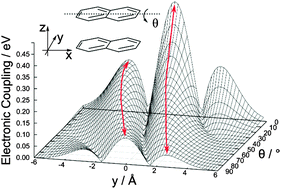Mapping the configuration dependence of electronic coupling in organic semiconductors†
Abstract
The ability to effectively transport charge carriers is often a key determinant concerning the deployment of materials derived from π-conjugated molecules and polymers in (opto)electronic applications. Theoretical models to evaluate charge-carrier transport parameters across a range of organic materials often work under the approximation of evaluating the intermolecular electronic couplings for supermolecular complexes (i.e. dimers) in the neutral state. Here, we investigate how the explicit inclusion of the nature of the charged state (i.e. both the neutral and radical-cation states) impacts the assessment of the intermolecular electronic couplings, and how considerations of the density functionals often used to determine these couplings effect the computed magnitude. From a materials perspective, we explore the role that the dimer configuration plays in determining the magnitudes of the electronic couplings for oligoacenes. The results suggest that appropriate consideration of translational alignment along the long and short acene axes, even in configurations with near perpendicular edge-to-face interactions, can lead to molecular packing arrangements in the solid state with large electronic couplings. These results give insight into ways to fine tune solid-state molecular packing to ensure the highest possible electronic couplings.

- This article is part of the themed collection: Small Molecules and Monodisperse Oligomers for Organic Electronics

 Please wait while we load your content...
Please wait while we load your content...